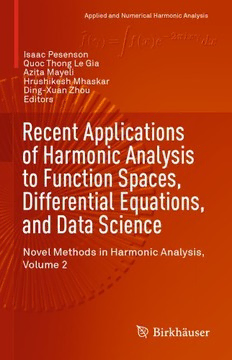Table Of ContentApplied and Numerical Harmonic Analysis
Isaac Pesenson
Quoc Thong Le Gia
Azita Mayeli
Hrushikesh Mhaskar
Ding-Xuan Zhou
Editors
Recent Applications
of Harmonic Analysis
to Function Spaces,
Differential Equations,
and Data Science
Novel Methods in Harmonic Analysis,
Volume 2
Applied and Numerical Harmonic Analysis
SeriesEditor
JohnJ.Benedetto
UniversityofMaryland
CollegePark,MD,USA
EditorialAdvisoryBoard
AkramAldroubi GittaKutyniok
VanderbiltUniversity TechnischeUniversitätBerlin
Nashville,TN,USA Berlin,Germany
DouglasCochran MauroMaggioni
ArizonaStateUniversity DukeUniversity
Phoenix,AZ,USA Durham,NC,USA
HansG.Feichtinger ZuoweiShen
UniversityofVienna NationalUniversityofSingapore
Vienna,Austria Singapore,Singapore
ChristopherHeil ThomasStrohmer
GeorgiaInstituteofTechnology UniversityofCalifornia
Atlanta,GA,USA Davis,CA,USA
StéphaneJaffard YangWang
UniversityofParisXII MichiganStateUniversity
Paris,France EastLansing,MI,USA
JelenaKovacˇevic´
CarnegieMellonUniversity
Pittsburgh,PA,USA
Moreinformationaboutthisseriesathttp://www.springer.com/series/4968
Isaac Pesenson (cid:129) Quoc Thong Le Gia
Azita Mayeli (cid:129) Hrushikesh Mhaskar
Ding-Xuan Zhou
Editors
Recent Applications
of Harmonic Analysis
to Function Spaces,
Differential Equations,
and Data Science
Novel Methods in Harmonic Analysis,
Volume 2
Editors
IsaacPesenson QuocThongLeGia
DepartmentofMathematics SchoolofMathematicsandStatistics
TempleUniversity UniversityofNewSouthWales
Philadelphia,PA,USA Sydney,NSW,Australia
AzitaMayeli HrushikeshMhaskar
DepartmentofMathematics InstituteofMathematicalSciences
TheGraduateCenter,CUNY ClaremontGraduateUniversity
NewYork,NY,USA Claremont,CA,USA
Ding-XuanZhou
DepartmentofMathematics
CityUniversityofHongKong
KowloonTong,HongKong
ISSN2296-5009 ISSN2296-5017 (electronic)
AppliedandNumericalHarmonicAnalysis
ISBN978-3-319-55555-3 ISBN978-3-319-55556-0 (eBook)
DOI10.1007/978-3-319-55556-0
LibraryofCongressControlNumber:2017939351
Mathematics Subject Classification (2010): 05E15, 11G15, 11R04, 11R09, 11R47, 11R56, 14F05,
33C10,33C55,33E12,35A25,35J25,41A15,42A16,42A38,42B10,42B35,42B37,42A99,42C99,
46L10,46L40,46L53,46L54,47B34,60G15,60G60,62D99,62-07,68P99,86A20,86A99,94A12,
94A20
©SpringerInternationalPublishingAG2017
Thisworkissubjecttocopyright.AllrightsarereservedbythePublisher,whetherthewholeorpartof
thematerialisconcerned,specificallytherightsoftranslation,reprinting,reuseofillustrations,recitation,
broadcasting,reproductiononmicrofilmsorinanyotherphysicalway,andtransmissionorinformation
storageandretrieval,electronicadaptation,computersoftware,orbysimilarordissimilarmethodology
nowknownorhereafterdeveloped.
Theuseofgeneraldescriptivenames,registerednames,trademarks,servicemarks,etc.inthispublication
doesnotimply,evenintheabsenceofaspecificstatement,thatsuchnamesareexemptfromtherelevant
protectivelawsandregulationsandthereforefreeforgeneraluse.
Thepublisher,theauthorsandtheeditorsaresafetoassumethattheadviceandinformationinthisbook
arebelievedtobetrueandaccurateatthedateofpublication.Neitherthepublishernortheauthorsor
theeditorsgiveawarranty,expressorimplied,withrespecttothematerialcontainedhereinorforany
errorsoromissionsthatmayhavebeenmade.Thepublisherremainsneutralwithregardtojurisdictional
claimsinpublishedmapsandinstitutionalaffiliations.
Printedonacid-freepaper
ThisbookispublishedunderthetradenameBirkhäuser,www.birkhauser-science.com
TheregisteredcompanyisSpringerInternationalPublishingAG
Theregisteredcompanyaddressis:Gewerbestrasse11,6330Cham,Switzerland
ANHA Series Preface
The Applied and Numerical Harmonic Analysis (ANHA) book series aims to
providetheengineering,mathematical,andscientificcommunitieswithsignificant
developments in harmonic analysis, ranging from abstract harmonic analysis to
basic applications. The title of the series reflects the importance of applications
and numerical implementation, but richness and relevance of applications and
implementation depend fundamentally on the structure and depth of theoretical
underpinnings. Thus, from our point of view, the interleaving of theory and
applicationsandtheircreativesymbioticevolutionisaxiomatic.
Harmonicanalysisisawellspringofideasandapplicabilitythathasflourished,
developed, and deepened over time within many disciplines and by means of
creative cross-fertilization with diverse areas. The intricate and fundamental rela-
tionship between harmonic analysis and fields such as signal processing, partial
differentialequations(PDEs),andimageprocessingisreflectedinourstate-of-the-
artANHAseries.
Our vision of modern harmonic analysis includes mathematical areas such as
wavelettheory,Banachalgebras,classicalFourieranalysis,time-frequencyanalysis,
andfractalgeometry,aswellasthediversetopicsthatimpingeonthem.
Forexample,wavelettheorycanbeconsideredanappropriatetooltodealwith
some basic problems in digital signal processing, speech and image processing,
geophysics, pattern recognition, biomedical engineering, and turbulence. These
areas implement the latest technology from sampling methods on surfaces to fast
algorithms and computer vision methods. The underlying mathematics of wavelet
theorydependsnotonlyonclassicalFourieranalysisbutalsoonideasfromabstract
harmonicanalysis,includingvonNeumannalgebrasandtheaffinegroup.Thisleads
toastudyoftheHeisenberggroupanditsrelationshiptoGaborsystems,andofthe
metaplectic group for a meaningful interaction of signal decomposition methods.
Theunifyinginfluenceofwavelettheoryintheaforementionedtopicsillustratesthe
justification for providing a means for centralizing and disseminating information
fromthebroader,butstillfocused,areaofharmonicanalysis.Thiswillbeakeyrole
of ANHA. We intend to publish with the scope and interaction that such a host of
issuesdemands.
v
vi ANHASeriesPreface
Alongwithourcommitmenttopublishmathematicallysignificantworksatthe
frontiersofharmonicanalysis,wehaveacomparablystrongcommitmenttopublish
majoradvancesinthefollowingapplicabletopicsinwhichharmonicanalysisplays
asubstantialrole:
Antennatheory Predictiontheory
Biomedicalsignalprocessing Radarapplications
Digitalsignalprocessing Samplingtheory
Fastalgorithms Spectralestimation
Gabortheoryandapplications Speechprocessing
Imageprocessing Time-frequencyand
Numericalpartialdifferentialequations time-scaleanalysis
Wavelettheory
TheabovepointofviewfortheANHAbookseriesisinspiredbythehistoryof
Fourieranalysisitself,whosetentaclesreachintosomanyfields.
In the last two centuries Fourier analysis has had a major impact on the
development of mathematics, on the understanding of many engineering and
scientificphenomena,andonthesolutionofsomeofthemostimportantproblems
in mathematics and the sciences. Historically, Fourier series were developed in
the analysis of some of the classical PDEs of mathematical physics; these series
were used to solve such equations. In order to understand Fourier series and the
kindsofsolutionstheycouldrepresent,someofthemostbasicnotionsofanalysis
were defined, e.g., the concept of “function.” Since the coefficients of Fourier
seriesareintegrals,itisnosurprisethatRiemannintegralswereconceivedtodeal
with uniqueness properties of trigonometric series. Cantor’s set theory was also
developedbecauseofsuchuniquenessquestions.
A basic problem in Fourier analysis is to show how complicated phenomena,
suchassoundwaves,canbedescribedintermsofelementaryharmonics.Thereare
twoaspectsofthisproblem:first,tofind,orevendefineproperly,theharmonicsor
spectrumofagivenphenomenon,e.g.,thespectroscopyprobleminoptics;second,
todeterminewhichphenomenacanbeconstructedfromgivenclassesofharmonics,
asdone,forexample,bythemechanicalsynthesizersintidalanalysis.
Fourieranalysisisalsothenaturalsettingformanyotherproblemsinengineer-
ing, mathematics, and the sciences. For example, Wiener’s Tauberian theorem in
Fourieranalysisnotonlycharacterizesthebehavioroftheprimenumbersbutalso
provides the proper notion of spectrum for phenomena such as white light; this
latterprocess leads totheFourier analysis associated withcorrelationfunctions in
filtering and prediction problems, and these problems, in turn, deal naturally with
Hardyspacesinthetheoryofcomplexvariables.
Nowadays, some of the theory of PDEs has given way to the study of Fourier
integral operators. Problems in antenna theory are studied in terms of unimodular
trigonometric polynomials. Applications of Fourier analysis abound in signal
processing, whether with the fast Fourier transform (FFT), or filter design, or the
adaptivemodelinginherentintime-frequency-scalemethodssuchaswavelettheory.
ANHASeriesPreface vii
The coherent states of mathematical physics are translated and modulated Fourier
transforms, and these are used, in conjunction with the uncertainty principle, for
dealing with signal reconstruction in communications theory. We are back to the
raisond’êtreoftheANHAseries!
CollegePark,MD,USA JohnJ.Benedetto
Preface
Wepresentthesecondoftwovolumes,whicharecomposedofmorethan30articles
related to harmonic analysis. Harmonic analysis is a very old topic, which still
continuestodrawtheinterestofmanymathematicians.Modernresearchinthisarea
ismotivated both bydeeper and new theoretical questions and numerous practical
applications. These volumes aim to provide a sample of some of these directions.
All the authors were selectively invited and comprise both senior and junior
mathematicians. We are pleased to have received an unexpectedly enthusiastic
responsetoourinvitations.
In response to the number of papers we received, it was suggested by
Birkhäuser/Springer to split our book into two volumes. Chapters in each volume
are organized into parts according to their topics, and the order of chapters in
each part is alphabetical. This first volume, entitled “Frames and Other Bases in
Abstract and Function Spaces” consists of 16 chapters. It is quite homogeneous
mathematicallysinceeverychapterrelatestothenotionofframesorbasesofother
types.Theintroductiontothisvolumecontainssomebasicnotionsofthetheoryof
frames and underlines the way the chapters fit into the general theme. The second
volume, which is called “Recent Applications of Harmonic Analysis to Function
Spaces, Differential Equations, and Data Science,” consists of 15 chapters and is
verydiverse.Itsintroductionisjustacollectionofextendedabstracts.
Wewereluckytoreceiveexcellentcontributionsbytheauthors,andweenjoyed
working with them. We deeply appreciate the generous help of many of our
colleagues who were willing to write very professional and honest reviews on
submissions to our volumes. We are very thankful to John Benedetto, who is the
series editor of the Birkhäuser Applied and Numerical Harmonic Analysis Series,
for his constant and friendly support. We appreciate the constant assistance of
Birkhäuser/SpringereditorsDanielleWalkerandBenjaminLevitt.Wearethankful
toMeyerPesensonandAlexanderPowellfortheirconstructivecommentsregarding
introductions. We acknowledge our young colleague Hussein Awala for his help
withorganizingfilesandtemplates.
ix
x Preface
We hope these volumes will be useful for people working in different fields of
harmonicanalysis.
Philadelphia,PA,USA IsaacPesenson
Sydney,NSW,Australia QuocThongLeGia
NewYork,NY,USA AzitaMayeli
Claremont,CA,USA HrushikeshMhaskar
KowloonTong,HongKong Ding-XuanZhou

